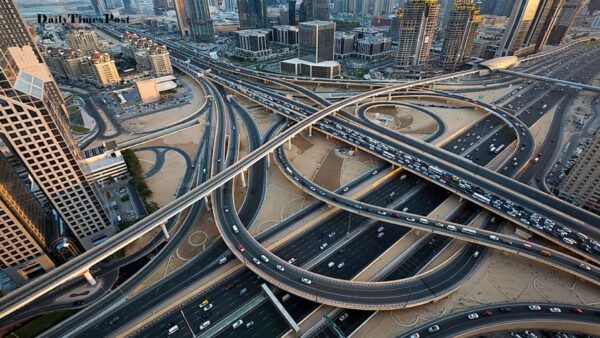Richest Muslim Countries: Thanks to abundant resources, economic reform, and strategic development, many Muslim-majority countries rank among the richest in the world. While oil and natural gas have historically driven much of their wealth, these nations are now actively diversifying to reduce reliance on energy exports. Here’s a look at the top 10 wealthiest Muslim countries in 2024 and how they’re reshaping their economies for the future.
Qatar
Qatar leads the list with an impressive GDP per capita of $118,150 in 2024. Known for its massive natural gas reserves, Qatar is among the world’s foremost energy producers. Hosting the 2022 FIFA World Cup spurred significant investment in infrastructure and development, diversifying Qatar’s economy to include finance, construction, and services. These investments have made Qatar a hub of prosperity and innovation.
United Arab Emirates (UAE)
With a GDP per capita of $92,950, the UAE showcases how a nation can flourish beyond oil. Known for iconic cities like Dubai and Abu Dhabi, the UAE has invested heavily in real estate, tourism, aviation, and renewable energy. Located at a strategic crossroads between East and West, the UAE is a vibrant global trade center, making it an economic powerhouse. Richest Muslim Countries
Saudi Arabia
Saudi Arabia, with a GDP per capita of $71,370, remains a top global oil producer. However, the kingdom is working to diversify its economy through its ambitious Vision 2030 plan. This strategy aims to reduce oil dependence by investing in sectors like health, education, tourism, and technology, paving the way for a more sustainable future.
Bahrain
Bahrain’s economy is supported by its advanced financial and banking sector, boasting a GDP per capita of $62,750. Though oil still plays a role, Bahrain is focusing on heavy industries, finance, and tourism. Its liberal trade policies and progressive approach toward a post-oil economy reflect Bahrain’s dynamic growth and adaptability in the Gulf region. Richest Muslim Countries
Kuwait
Kuwait has a GDP per capita of $53,760, supported by some of the world’s largest oil reserves, estimated at 10% of the global total. The Kuwait Investment Authority, the world’s oldest sovereign wealth fund, supports its economy, and the nation’s “New Kuwait” plan aims to expand into sectors beyond oil by 2035, driving sustainable growth.
Turkey
Turkey’s GDP per capita of $43,620 reflects its diversified economy. Its location as a bridge between Europe and Asia, combined with robust industrial and agricultural sectors and a growing tourism industry, keeps Turkey’s economy dynamic. A youthful population and ongoing investments in infrastructure and technology continue to fuel Turkey’s economic ascent.
Oman
With a GDP per capita of $40,020, Oman is steadily moving away from oil dependence. The nation is expanding its tourism, shipping, and logistics sectors, investing in ports and free zones to attract international trade. Oman’s strategic location along the Arabian Peninsula’s southeast coast positions it as a key player in the Gulf’s economic landscape. Richest Muslim Countries
Malaysia
Malaysia’s GDP per capita of $39,070 stems from its diversified economy, driven by manufacturing, services, and natural resources such as palm oil and rubber. The country is also a major exporter of technology products, including semiconductors and electronics, and continues to focus on high-tech industries to support long-term growth.
Kazakhstan
Kazakhstan, with a GDP per capita of $34,480, is a Central Asian leader in natural resources, particularly oil, gas, and minerals. The “Kazakhstan 2050 Strategy” aims to expand the economy beyond energy into agriculture, finance, and technology. Its vast territory and location make it a vital trade link between Asia and Europe. Richest Muslim Countries
Libya
Despite political and economic challenges, Libya has a GDP per capita of $26,530, largely driven by oil exports. Libya’s economic stability and growth depend on national reconciliation and investment in reconstruction efforts to tap into its natural wealth and potential.
Conclusion
These top 10 Muslim-majority nations demonstrate resilience and adaptability, using wealth to build diverse, future-ready economies. With continued development and diversification, these countries are likely to maintain their status as some of the wealthiest in the world for years to come.
FAQs about Richest Muslim Countries
How is Qatar’s wealth sustained?
Qatar’s wealth is primarily due to its vast natural gas reserves, which fuel a significant portion of the global energy market. Recent infrastructure investments also contribute to its economy, enhancing its status as a prosperous, diversified nation.
What sectors support the UAE’s economy beyond oil?
The UAE has heavily invested in tourism, real estate, aviation, and renewable energy, positioning itself as a global trade and tourism hub, especially with high-profile projects in cities like Dubai and Abu Dhabi.
What is Saudi Arabia’s Vision 2030?
Vision 2030 is Saudi Arabia’s plan to diversify its economy, reducing oil dependence by expanding sectors like tourism, technology, and renewable energy, with an emphasis on public service improvements. Richest Muslim Countries
How is Kazakhstan diversifying its economy?
Kazakhstan’s “Kazakhstan 2050 Strategy” aims to shift its economy from energy to include agriculture, finance, and tech industries, leveraging its strategic location between Europe and Asia to boost trade.
Why is Libya’s economy still dependent on oil?
Libya’s political and economic instability has made diversification challenging. Oil remains its primary export, but stabilization and reconstruction efforts could lead to broader economic growth in the future.

